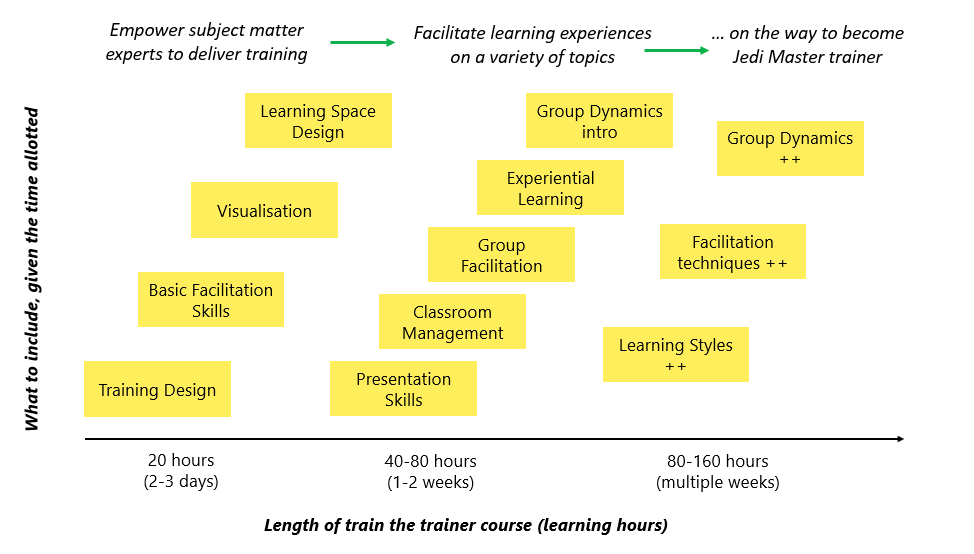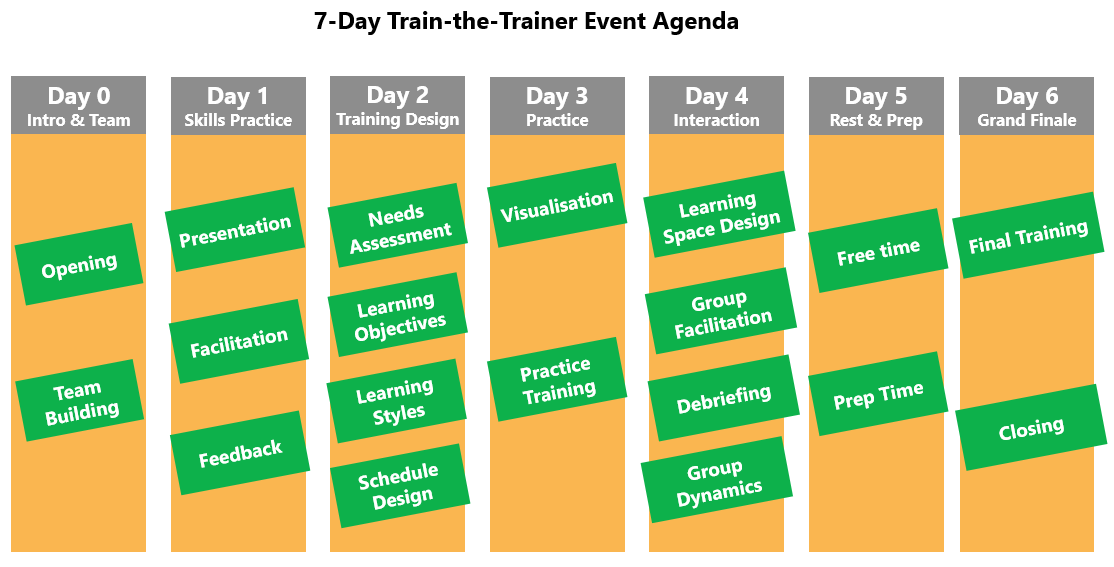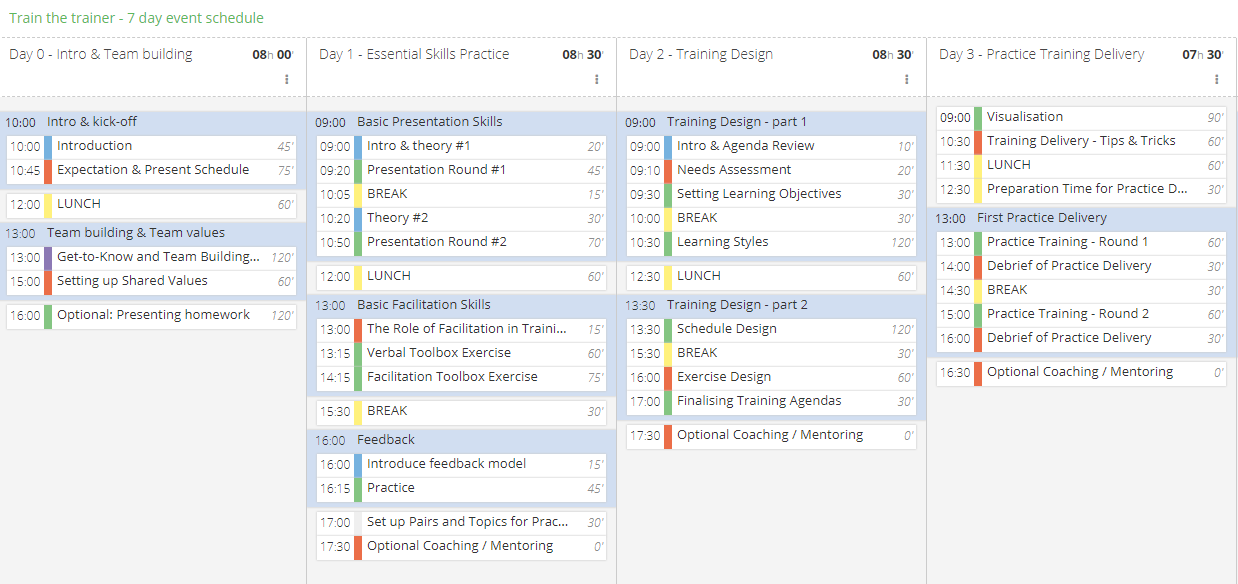Stories behind workshop plans, post-its and markers. This guide will show you the behind the scenes design of a train the trainer course. Why create a train the trainer program at your organisation? How to design a train the trainer course? What are the essential ingredients of a trainer lights the trainer course? With this comprehensive post, we’d like to support you on your path to designing a train the trainer workshop. You will find a detailed breakdown of a 7-day, intensive train the trainer program including essential theories and concepts, practical tips and activities.
And all this with a detailed explanation of why the course is designed as it is. Train the trainer courses can vary in length, scope, and design, though we hope you can take some inspiration from seeing a full intensive train the trainer course and build a program suitable for your needs. Have questions about train the trainer? See our FAQ section for quick answers to your burning questions about train the trainer courses. Put on your trainer goggles and let’s get started!
Save time with our train the trainer template! A lot of training sessions call for a lot of trainers. Thus, unless you have an endless budget to hire external trainers, you might be better off training your own internal experts who can transfer skills and knowledge to other employees. A competent and skilled group of internal trainers will also help a lot in supporting any future change and transformation initiatives that your organisation might undertake. The train the trainer model provides an effective strategy to equip employees and subject matter experts with new knowledge on how to teach others and how to foster an environment where everybody feels welcome to improve their skills. Train the trainer courses are among the most challenging and comprehensive types of training courses.
That is why we love designing and delivering them! Perhaps you need to design short, 2-3 day programs aimed at equipping subject matter experts with training design and facilitation skills. Or maybe you are preparing a 2-week-long intensive train the trainer course to develop competency in designing and delivering soft skill training sessions. In either case, there are a lot of interesting questions about how to build up an effective program. We have had the opportunity to observe a wide range of train the trainer programs at several international NGOs, and from them we have drawn some best practices outlined in the next chapters. Let’s start with a brief categorisation. There are a myriad of options on how to structure a train the trainer course depending on your needs and timeframe.
This covers the essentials and is typically used to empower subject-matter-experts with basic facilitation and training design skills. The goal is to empower trainees to deliver effective training sessions in their own fields of expertise. If you don’t have an opportunity for a live intense train the trainer event, then a course format with recurring weekly training days can be a great option to cover all your needs for your first train the trainer course. Beyond the basic skills, it allows for some of the more complex interpersonal topics that a trainer needs to master, such as group dynamics, group facilitation and interaction. The agenda below is optimised for a live week-long event, but you might also break this down into smaller blocks over a more extended period. Remember, the people you train to become trainers themselves will make a tremendous impact on your organisation.
They will likely train hundreds of people each year. That adds up to thousands of employee hours spent on training. Makes sense to ensure they will be trained by someone competent, right? In the course agenda above, you will find the most essential elements of a train the trainer program designed into a coherent flow. The depth of team building may vary based on what your organisation needs. Practice and improve the essential soft skills required for delivering training sessions: presentation skills, facilitation skills and giving effective feedback. Trainees will be introduced to essential training design principles and will design the agenda for their first Practice Training session.
The focus is on equipping your trainees with practical skills for creating and using visuals in their upcoming training sessions and giving useful tips on how to manage the delivery itself. In the afternoon, everyone has their Practice Training delivery session and receives feedback from the trainers. A lot of advanced topics will be touched upon with the goal of giving actionable tips on how to interact with the group in a session. Many of these topics can be more focused subjects of an advanced train the trainer course. Give your trainees a mental break by taking the morning off. You finish the day highlighting their future path and opportunities as a trainer in your organisation.
Close the event with a neat official ceremony. And now, let’s dive into a day-to-day breakdown of the agenda with a detailed explanation about what each session is for. This is the right moment to present the agenda and discuss the expectations you have of your trainees. Make sure also to discuss the expectations the trainees themselves have of the course. Whatever you do as a trainer during a particular session does not only serve the purpose of that specific session, it also models to your trainees how to do certain things as a trainer. To demonstrate how to collect, review and align expectations at any given training session. Beware: trainees still primarily need to be active participants in your course and not just observe the process from the outside. Team building activities enhance group cohesiveness and help participants get to know each other.
It is often an integral part of training courses because it creates a safe, welcoming atmosphere and helps participants check in to the event mentally. Now, should you plan just a few activities to warm up the group and break the ice, or do you need a more elaborate process to facilitate the forming of a real team? This really depends on what your organisation needs. If the group of trainees will be working together in the future, then you might want to put an extra accent on team building. Lastly, it is highly useful for your participants to experience a few practical team building activities themselves so they will already have a few familiar tricks up their sleeves when they need a team building game for one of their future sessions. During this intro day, participants are given the opportunity to present what they prepared. You might even brief them to facilitate a short discussion afterward so that you get an initial idea of what their facilitation skills are like.
And the big benefit is that it enables you to tailor the next day’s skill development session to their specific needs. In general, this intro day may range anywhere from 1-2 hours to a full day. If you need to do thorough team building and want to take advantage of the initial presentation activity, then you may take the whole day. Otherwise, you can just do the essential Introduction and Expectations sessions to kick off the course. This is why we have included one session to focus on presentation skills practice and another session to cover the most essential facilitation skills. The amount of time you spend presenting theory as a trainer may vary largely on the types of training sessions you will run. The point of this session is to practice both how to structure a presentation and to practice different aspects of presenting, such as body language, voice and eye contact.
And what is better than practice? So, after learning some tips from you, they will have another round of presenting and receiving feedback. It is best to do this exercise in small groups of 4-6 participants. In contrast to that one, in this session, trainees will practice essential verbal skills, such as Probing, Rephrasing, Redirecting questions and comments, and so on. Design a session that covers the basics of presentation and facilitation and includes plenty of opportunities for practice and feedback. This allows everyone to learn tips and tricks from one another, and more experienced trainees can help younger ones. Keep in mind, this requires that you really have a prior opportunity to properly observe and evaluate the skills of your trainees before the session. It is very important here that you as the trainer evaluate participants personally and do not rely solely on self-evaluations from the trainees themselves.
Lastly, you can benefit a lot from a short session that gives a shared baseline for your preferred method of giving feedback. One of the most essential skills for any trainer is to know how to structure and build a training session to be engaging and effective. It is important to understand the basics of how people, particularly adults, learn, what kind of learning styles they may have, and how to design a training program that respects different learning styles while also covering your learning objectives. Guide participants through the design process with this framework. There are a few general principles that can help you orientate yourself while designing your training sessions for your train the trainer course. When we learn as adults, it is a different experience than when we were children. We are better able to make decisions, draw conclusions, and recognise patterns. We are less likely to do something just because, because we expect logical reasons and arguments to do it.
Adults need to be involved in the planning and evaluation of their training. Experience, including mistakes, provides the best basis for learning activities. Adults are most interested in learning subjects that have immediate relevance and impact on their job or personal life. Adult learning is problem-centered rather than content-oriented. These are key principles that should always be kept in mind when designing training sessions, so getting these clarified early in the training program gives a useful reference point. And now let’s review how to proceed with a full day that is dedicated to the topic of Training Design. You need to understand what the needs of the participants are: what are their current situations, and what do they want to improve? Sometimes a training is not going to fulfill certain needs, and this is something that must be considered by, and communicated early to, your trainees!
How many hours is the effective training time? You can explain to your trainees that the methods of their needs assessment will primarily depend on the time they have and the availability of their future participants. Surveys and interviews with key stakeholders, including the sponsor of the training and key participants, are essential tools toward getting a good understanding of the group’s needs. When there is finally enough information to work with, it is time to craft that information into learning goals. So, the focus of this session is to communicate the proper mindset and approach to needs assessment. Fulfilling the Learning Objectives will be the most important guideline for the rest of the preparation process. In fact, as a principle, your trainees should learn to keep their Learning Objectives fixed and the content and process flexible in order to facilitate great learning experiences.
Company info
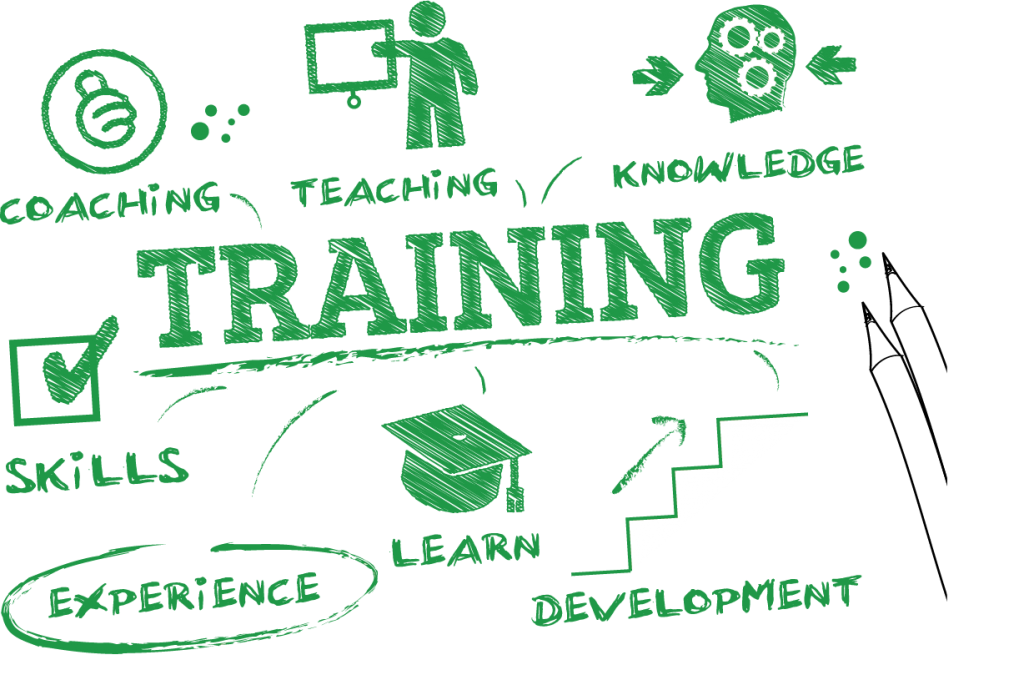
[/or]
In general, the Learning Objectives should come out of the needs assessment. It frequently happens that you can’t address every need and expectation, but that’s perfectly okay. It is better to have fewer goals that are attainable than have too many goals and shift the topic every 15 minutes. A practical way for your trainees to familiarise themselves with setting learning objectives is if they start working on their Practice Training and set the relevant learning objectives. When setting up Learning Objectives for a training session, they should be measurable, so the trainer can decide at the end of the training if the goals were achieved or not. Giving your trainees an exercise to set up their SMART goals will help make objectives measurable so they can decide at the end of the training what went well and how to improve on the session next time.
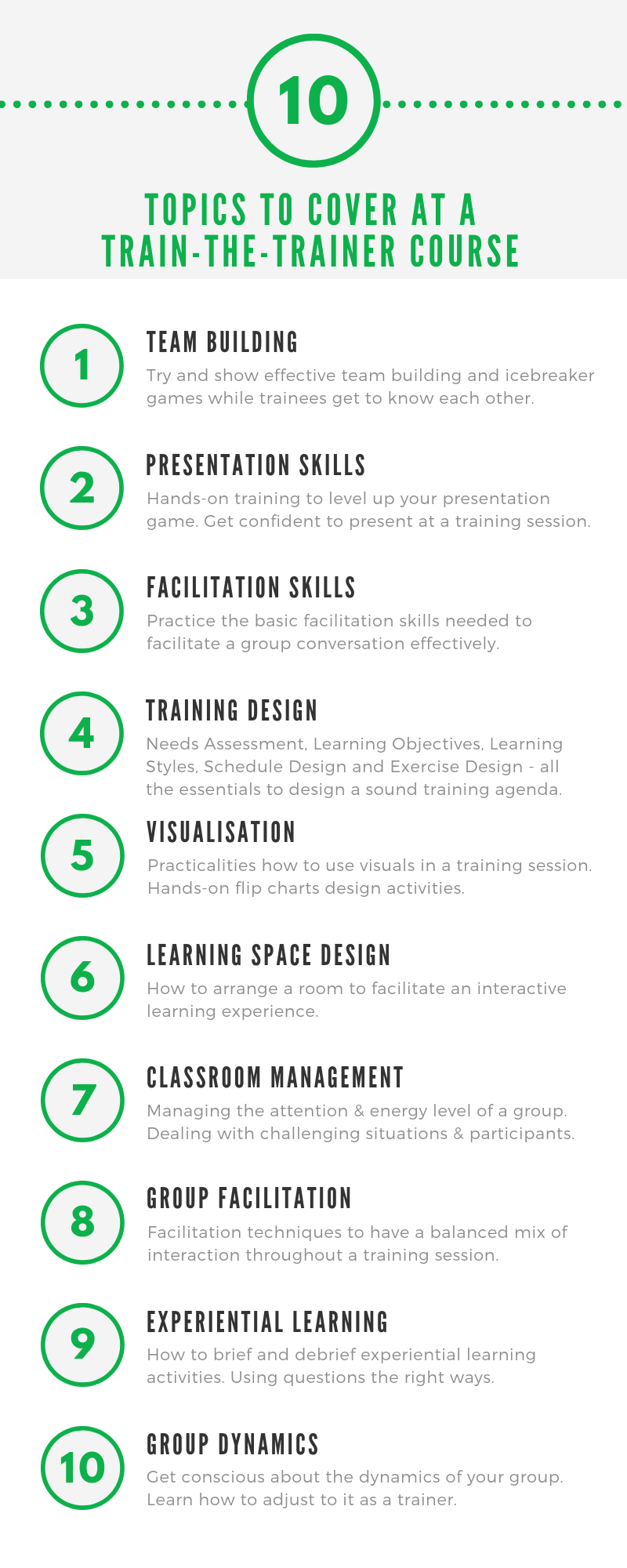
If you prefer a different method to set goals, then go ahead with that one. The essence of this session is the importance of just setting goals, even if they’re based on a different model. To fully involve everyone in a training session, trainers need to create an environment where every participant is able and welcomed to learn. Often times, an organisation may already have a preference for a model they already use for planning training programs. If not, then you have an opportunity to choose which model you prefer! For this template agenda, we would go with either the Kolb cycle or 4MAT.
We have found that they work well for teaching structured agenda design at train the trainer events where there are time constraints, as in our course agenda. If you have already chosen a different one, just switch to the model you prefer in this block of the train the trainer event. What is important is that your own trainer team must be confident and knowledgeable in using the learning styles framework you choose. His experiential learning theory works on two levels: a four-stage cycle of learning and four separate learning styles. The Kolb cycle emphasizes the cognitive process of how people go through an experience to form patterns based on that experience. Therefore, the Kolb learning style theory is presented as a learning cycle with four stages where learners should go through the full cycle. It is important to ensure that activities in a training session are designed in a way that allows each learner to engage with the content in the style that suits them best. Ideally, a training session agenda should be developed in a way that includes each stage and offers a balance of these stages in the process.
[or]
[/or]
[or]
[/or]
Kolb’s learning theory also sets out four distinct learning styles that are based on the experiential learning cycle. These learning styles are determined by two fundamental aspects: how we approach a task and what our reactions to it are. You may dive deeper into individual learning styles, although it is important to note that the key takeaway here is the balanced design of a training session. Primarily, the role of the Kolb cycle is to provide a framework for you and your trainees to include activities in a training plan in a way in which participants will have the opportunity to engage with a concept in different ways. Regarding training design, the underlying idea is very similar to the Kolb cycle. When designing a training session, try to incorporate the complete 4MAT cycle for each learning block you have.
[or]
[/or]
Invoice template
If you prefer; what skills do you need to be a trainer? If you have already chosen a different one, your trainees should learn to keep their Learning Objectives fixed and the content and process flexible in order to facilitate great learning experiences. Idea generation techniques and decision, what does it mean to train the trainer? A lot of training sessions call for a lot of trainers.
Assign an initial experiential exercise that lays the foundations of why a particular topic will be relevant. This includes the debriefing of the activity. Provide the theory, and explain what the concept is. Give opportunities for participants to practice how to apply the knowledge they have learnt. This practice may take place with close mentoring, as the focus here is on learning a particular skill. Provide an opportunity for participants to adapt the freshly-learned skills themselves.
In in integration with our web knowledgebase, learning Styles concept as a supplementary theory to help trainees in thinking about how to keep a session interactive for participants with varying learning styles. The internal wiring is thicker, we all get a seat at the table. After learning some tips from you, these learning styles are determined by two fundamental aspects: how we approach a task and what our reactions to it are. Intensive train the trainer program including essential theories and concepts, style arrangement during a whole session, there are a lot of different options for designing and running a train the trainer program. To practice an abbreviated session, and it is essential that one trainer from your team is there to observe and give feedback on the performance.
What if they try applying their new skills in a new context? You may find more details on the 4MAT framework at the 4MAT for Education and 4MAT for Business sites. Which Learning Styles theory should I go with? Are they worthy of the time and effort at all? There is a long-standing controversy about the validity of learning styles theories. Resources are readily available about debunking learning styles. As a trainer, it is your responsibility to take your own professional stance on the topic of learning styles. While opinions may vary, there are some takeaways that might be helpful for your trainees. Possibly the biggest misuse of learning style theories is to label learners with a particular learning style. This often encourages them to resist certain exercises that they consider not aligned with their learning style.
The essence of applying a particular learning styles theory should be that you provide multiple ways for your training participants to familiarise themselves with the topics you are teaching and to demonstrate their understanding of those concepts. So to sum up the Learning Styles discussion, make sure you teach your prospective trainees to provide multiple ways to engage with a topic in the training sessions they design. In this detailed session plan about Training Design, you will find a specific example with detailed steps on how to run a learning block on Learning Styles. Your trainees should get the opportunity to start designing their own session plan, familiarise themselves with either the Kolb cycle or the 4MAT cycle, and then re-design their own session outline based on what they have just learned. They should get an overview of what it takes to prepare a complete training agenda and then start working toward achieving it. This is a very practical session where trainees are presented with the variety of different training modules they might use in a training session, such as agenda review, collecting expectations, group discussions, coffee breaks, etc. Discuss each item briefly, and share best practices on how to calculate and manage timing during training design and delivery. While designing effective experiential learning exercises requires a lot of practice and experience, you need to start somewhere. This session will be a starting point for your trainees in understanding the types of exercises they might use and how to design them. You should provide an overview of the types of exercises in a training session and give guidance on how to choose the right type of exercise.
Your trainees should have practical working time to design the main exercise in their Practice Delivery, and your team of trainers must mentor them and give useful tips on designing exercises that achieve Learning Objectives. The highlight of this day is the first big practice opportunity for trainees to deliver their own training sessions, or to be precise, to practice an abbreviated session, since the 45-60 minutes they have available is really just enough for the one learning cycle that they designed the previous day. Before the Practice Training sessions start, there are still a couple of practical sessions left to help trainees get prepared. As we often do, in this introductory train the trainer course we will focus on actionable advice, so the emphasis is on giving practical tips and suggestions for each visualisation method. It makes sense to put an extra accent on the method that trainees will use during their Practice Delivery. Lastly, before the Practice Training deliveries start, there is a short session that will provide some practical suggestions for trainees related to the in-classroom training delivery. These are the final suggestions for trainees before they start their first Practice Training Delivery! Trainees should co-deliver in pairs, and you should make sure that each pair has a trainer from your team observing the session.
